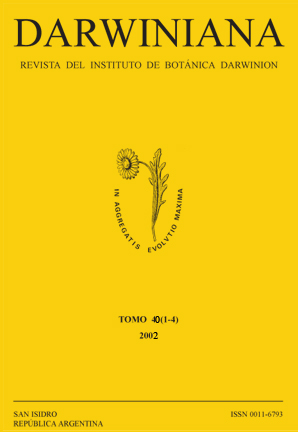LARREA INTERSPECIFIC HYBRIDS REVISITED (ZYGOPHYLLACEAE)
DOI:
https://doi.org/10.14522/darwiniana.2014.401-4.241Keywords:
Zygophyllaceae, Larrea hybrids, CytogeneticsAbstract
Evidence from recent molecular studies suggested a reappraisal of genome relationships between Larrea ameghinoi and the other South American species of the genus. As a consequence, new attemps to study the meiotic pairing of the L. ameghinoi x L. cuneifolia hybrids were undertaken (2n = 3x = 39). Mean number of bivalents and univalents were 9.8 and 19.4, respectively. Since the basic number x is 13, the interpretation that is favored is that L. ameghinoi (2n = 2x = 26) (AA) and L. cuneifolia (2n = 4x = 52) (DDCC) share partially homeologous genomes (A and C) that are involved in most bivalent pairing and this would explain the partial seed fertility of these triploid hybrids (15-19.4 %). L. ameghinoi genome (A) could have retained several parts of an ancestral genome which makes possibleat least some pairing with those of the other species and enable it to function as a pivotal genome producing some fertility (from partial to complete) in all the possible hybrid combinations with its three South American congeners. An appendix is included with the captions of the figures of chapter 2 from the book edited by Mabry et al. (1977) which were erroneously omitted in the editorial and printing process.
Downloads
Published
31-12-2002
How to Cite
Hunziker, J. H., & Comas, C. (2002). LARREA INTERSPECIFIC HYBRIDS REVISITED (ZYGOPHYLLACEAE). Darwiniana, Nueva Serie, 40(1-4), 33–38. https://doi.org/10.14522/darwiniana.2014.401-4.241
Issue
Section
Reproductive Biology
License

Starting on 2012, Darwiniana Nueva Serie uses Licencia Creative Commons Atribución-NoComercial 2.5 Argentina .






